Innovative Approach on Teaching and Learning with Technical Aids for STEM Education at the Primary Level
Abstract
:1. Introduction
2. Theoretical Background
2.1. Integrated STEM Education
2.2. Innovative Tools for STEM Education
2.3. Implementation of STEM Education Projects in Slovak Primary Schools
3. Mechatronics Kit in Education of Future Primary Education Teachers
4. Conducted Research
4.1. Problematization and Goal of Research
4.2. Research Questions (RQ)
4.3. Organization of Research and Applied Methods
4.4. Phases of Research Implementation over Time
4.5. Procedure of Activities
- Students divided their work into several stages where they documented their work with photographs, and finally documented the functionality of the device with a short video (Figure 1);
- 2.
- Preparation of the engines (Figure 2);
- 3.
- Preparation of the structure and connecting the basic construction to the carousel (Figure 3);
- 4.
- In the frame of step 4 are the following activities of the students including connecting other parts to the basic structure: constructing the rear section, connecting the rear section to the whole. The students also completed the rotating parts, connecting the cables to the component with the electric battery (Figure 4);
- 5.
- The last step for the students in creating the device is connecting it to the computer and to the application (Figure 5).
- 6.
- The last step for the students in creating the device is connecting it to the computer and to the application (Figure 6).
- 1.
- Within this group, the students reached a consensus to build a smoothie mixer. They determined that they had a sufficient number of parts from the kit to execute their plan. Although the teacher asked them to create sketches, the students chose not to do so. Instead, they began constructing the device directly. When certain parts did not function as intended, they addressed the issues through mutual discussion. It can be said that they only had a shared vision of the device, and they constructed it through a trial-and-error approach. Ultimately, they successfully built the device in a manner that left all group members satisfied. During this phase, the group exhibited a highly enthusiastic mood and euphoric emotions (Figure 7);
- 2.
- Subsequently, the students developed a photo tutorial for their design. During this process, it became apparent that they could not recall certain steps. Consequently, they decided to disassemble the device and, in turn, capture photos to include them in the instructions in reverse order. A cognitive boost was observed within this group as they tackled this task. The students asserted that they had devised an algorithm for constructing the whisk of the smoothie blender (Figure 8, Figure 9 and Figure 10);
- 3.
- Once the device was assembled, the students transitioned to the post-active phase, which occurred in the classroom. Students were to discuss the challenges encountered during construction based on the developed instructions. They engaged in conversations about the mistakes made and the success of their solutions. Collectively, they documented their feedback, which we provide below (sample):
“We were inspired by the wheel, which we used as the basis for the construction of the whisk of our smoothie blender. Our blender is functional, we’ve included a video that demonstrates its functionality. We are proud of our work. We enjoyed working together on this activity. We think this activity would be suitable for primary school children. But for some of us it was difficult to find specific information about the history of the mixer”.
5. Discussion and Conclusions
- Creativity and effective teamwork were apparent in every student group;
- Students in each group demonstrated excellent skills in designing the device;
- Proficient search on the Internet for information about the devices was identified, though some encountered challenges in finding specific details such as the history of a particular device;
- Exceptional team problem-solving skills were showcased;
- High-level constructive discussions among students were observed;
- Groups approached the creation of a new device and the documentation of instructions with creativity;
- Upon successfully creating a new device, they exhibited motivation for similar activities in the future.
Author Contributions
Funding
Institutional Review Board Statement
Informed Consent Statement
Data Availability Statement
Acknowledgments
Conflicts of Interest
References
- Redecker, C. European Framework for the Digital Competence of Educators: DigCompEdu; EUR 28775 EN; Punie, Y., Ed.; Publications Office of the European Union: Luxembourg, 2017. [Google Scholar] [CrossRef]
- Pupala, B.; Fridrichová, P. (Eds.) Education for the 21st Century—Background to Changes in the Primary Education Curriculum [Vzdelávanie pre 21. Storočie—Východiská Zmien v Kurikule Základného Vzdelávania]; Štátny pedagogický ústav: Bratislava, Slovakia, 2022. [Google Scholar]
- Houghton, T.; Oldknow, A.; Diego-Mantecón, J.; Fenyvesi, K.; Crilly, E.; Lavicza, Z. KIKS Creativity and Technology for All. Open Educ. Stud. 2019, 1, 198–208. [Google Scholar] [CrossRef]
- Conde, M.Á.; Sedano, F.J.R.; Fernández-Llamas, C.; Gonçalves, J.; Lima, J.; García-Peñalvo, F.J. RoboSTEAM Project Systematic Mapping: Challenge Based Learning and Robotics. In Proceedings of the 2020 IEEE Global Engineering Education Conference (EDUCON), Porto, Portugal, 27–30 April 2020; IEEE: Piscataway NJ, USA, 2020; pp. 214–221. [Google Scholar] [CrossRef]
- Skinner, E.; Saxton, E.; Currie, C.; Shusterman, G. A motivational account of the undergraduate experience in science: Brief measures of students’ self-system appraisals, engagement in coursework, and identity as a scientist. Int. J. Sci. Educ. 2017, 39, 2433–2459. [Google Scholar] [CrossRef]
- World Economic Forum. Realizing Human Potential in the Fourth Industrial Revolution: An Agenda for Leaders to Shape the Future of Education, Gender and Work; World Economic Forum: Geneva, Switzerland, 2017; Available online: http://www3.weforum.org/docs/WEF_EGW_Whitepaper.pdf (accessed on 1 March 2024).
- Nadelson, L.S.; Seifert, A.L. Integrated STEM defined: Contexts, challenges, and the future. J. Educ. Res. 2017, 110, 221–223. [Google Scholar] [CrossRef]
- Kennedy, T.J.; Tunnicliffe, S.D. Introduction: The role of Play and STEM in the Early Years. In Play and STEM Education in the Early Years: International Policies and Practices; Tunnicliffe, S.D., Kennedy, T.J., Eds.; Springer: Cham, Switzerland, 2022; Chapter 1; pp. 3–37. [Google Scholar] [CrossRef]
- Takeuchi, M.A.; Sengupta, P.; Shanahan, M.C.; Adams, J.D.; Hachem, M. Transdisciplinarity in STEM education: A critical review. Stud. Sci. Educ. 2020, 56, 213–253. [Google Scholar] [CrossRef]
- Bybee, R.W. The Case for STEM Education: Challenges and Opportunities; NSTA Press: New York, NY, USA, 2013. [Google Scholar]
- Guzey, S.S.; Harwell, M.; Moore, T. Development of an instrument to assess attitudes toward science, technology, engineering, and mathematics (STEM). Sch. Sci. Math. 2014, 114, 271–279. [Google Scholar] [CrossRef]
- Baran, E.; Bilici, S.C.; Mesutoglu, C.; Ocak, C. Moving STEM beyond schools: Students’ perceptions about an out-of-school STEM education program. Int. J. Educ. Math. Sci. Technol. 2016, 4, 9–19. [Google Scholar] [CrossRef]
- Cameron, S.; Craig, C. STEM Labs for Middle Grades, Grades 5–8; Mark Twain Media: Quincy, IL, USA, 2016. [Google Scholar]
- Hsu, Y.S.; Lin, Y.H.; Yang, B. Impact of augmented reality lessons on students’ STEM interest. Res. Pract. Technol. Enhanc. Learn. 2017, 12, 2. [Google Scholar] [CrossRef] [PubMed]
- Yildirim, B.; Türk, C. The effectiveness of argumentation-assisted STEM practices. Cypriot J. Educ. Sci. 2018, 13, 259–274. [Google Scholar] [CrossRef]
- Vasquez, J.A.; Comer, M.; Gutierrez, J. Integrating STEM Teaching and Learning into the K-2 Classroom; NSTA Press: Arlington, VA, USA, 2020. [Google Scholar]
- Dugger, W.E. Evolution of STEM in the United States. In Proceedings of the 6th Biennial International Conference on Technology Education Research, Queensland, Australia, 8–11 December 2010. [Google Scholar]
- Kelley, T.R.; Knowles, J.G. A conceptual framework for integrated STEM education. Int. J. STEM Educ. 2016, 3, 11. [Google Scholar] [CrossRef]
- Spelt, E.J.H.; Biemans, H.J.A.; Tobi, H.; Luning, P.A.; Mulder, M. Teaching and learning in interdisciplinary higher education: A systematic review. Educ. Psychol. Rev. 2009, 21, 365–378. [Google Scholar] [CrossRef]
- Hernandez, P.; Bodin, R.; Elliott, J.; Ibrahim, B.; Rambo-Hernandez, K.; Chen, T.; de Miranda, M. Connecting the STEM dots: Measuring the effect of an integrated engineering design intervention. Int. J. Technol. Des. Educ. 2014, 24, 107–120. [Google Scholar] [CrossRef]
- Erdogan, N.; Navruz, B.; Younes, R.; Capraro, R.M. Viewing How STEM Project-Based Learning Influences Students’ Science Achievement through the Implementation Lens: A Latent Growth Modeling. Eurasia J. Math. Sci. Technol. Educ. 2016, 12, 2139–2154. [Google Scholar] [CrossRef]
- Firat, E.A. Science, technology, engineering, and mathematics integration: Science teachers’ perceptions and beliefs. Sci. Educ. Int. 2020, 31, 104–116. [Google Scholar] [CrossRef]
- Becker, K.H.; Park, K. Effect of integrative approaches among science, technology, engineering, and mathematics (STEM) subjects on students’ learning: A meta-analysis. J. STEM Educ. Innov. Res. 2011, 12, 23–37. [Google Scholar] [CrossRef]
- Lamb, R.; Akmal, T.; Petrie, K. Development of a cognition-priming model describing learning in a STEM classroom. J. Res. Sci. Teach. 2015, 52, 410–437. [Google Scholar] [CrossRef]
- Cotabish, A.; Dailey, D.; Robinson, A.; Hughes, G. The effects of a STEM intervention on elementary students’ science knowledge and skills. Sch. Sci. Math. 2013, 113, 215–226. [Google Scholar] [CrossRef]
- Alsoliman, B.S.H. Virtual robotics in education: The experience of eighth grade students in STEM. Front. Educ. 2022, 7, 950766. [Google Scholar] [CrossRef]
- Hyatt, K.; Barron, J.; Noakes, M. Video Gaming for STEM Education. In Cases on E-Learning Management: Development and Implementation; Yang, H., Wang, S., Eds.; Information Science Reference: Hershey, PA, USA, 2013; pp. 103–117. [Google Scholar] [CrossRef]
- Kennedy, T.; Odell, M. Engaging students in STEM education. Sci. Educ. Int. 2014, 25, 246–258. [Google Scholar]
- Renken, M.; Peffer, M.; Otrel-Cass, K.; Girault, I.; Chiocarriello, A. (Eds.) Simulations as Scaffolds in Science Education; Springer Briefs in Educational Communications and Technology; Springer: Cham, Switzerland, 2016. [Google Scholar] [CrossRef]
- Wang, L.H.; Chen, B.; Hwang, G.J.; Guan, J.Q.; Wang, Y.Q. Effects of digital game-based STEM education on students’ learning achievement: A meta-analysis. Int. J. STEM Educ. 2022, 9, 26. [Google Scholar] [CrossRef]
- Sanzana, M.R.; Abdulrazic, M.O.M.; Wong, J.Y.; Karunagharan, J.K.; Chia, J. Gamified virtual labs: Shifting from physical environments for low-risk interactive learning. J. Appl. Res. High. Educ. 2023; ahead of print. [Google Scholar] [CrossRef]
- Levin, I.; Tsybulsky, D. (Eds.) Digital Tools and Solutions for Inquiry-Based STEM Learning; IGI Global: Hershey, PA, USA, 2017. [Google Scholar] [CrossRef]
- Villena-Taranilla, R.; Tirado-Olivares, S.; Cózar-Gutiérrez, R.; González-Calero, J.A. Effects of virtual reality on learning outcomes in K-6 education: A meta-analysis. Educ. Res. Rev. 2022, 35, 100434. [Google Scholar] [CrossRef]
- Papert, S. Mindstorms: Children, Computers, and Powerful Ideas; Basic Books, Inc.: New York, NY, USA, 1980. [Google Scholar]
- Kim, C.; Kim, D.; Yuan, J.; Hill, R.B.; Doshi, P.; Thai, C.N. Robotics to promote elementary education pre-service teachers’ STEM engagement, learning, and teaching. Comput. Educ. 2015, 91, 14–31. [Google Scholar] [CrossRef]
- Williams, D.C.; Ma, Y.; Prejean, L.; Ford, M.J.; Lai, G. Acquisition of physics content knowledge and scientific inquiry skills in a robotics summer camp. J. Res. Technol. Educ. 2007, 40, 201–216. [Google Scholar] [CrossRef]
- Ortiz, A.M. Fifth grade students’ understanding of ratio and proportion in an engineering robotics program. In Proceedings of the 2011 ASEE Annual Conference & Exposition, Vancouver, BC, Canada, 26–29 June 2011; Tufts University: Medford, MA, USA, 2011. [Google Scholar]
- Alfieri, L.; Higashi, R.; Shoop, R.; Schunn, C.D. Case studies of a robot-based game to shape interests and hone proportional reasoning skills. Int. J. STEM Educ. 2015, 2, 4. [Google Scholar] [CrossRef]
- Lepuschitz, W.; Merdan, M.; Koppensteiner, G.; Balogh, R.; Obdržálek, D. (Eds.) Robotics in Education: Latest Results and Developments; Springer: Berlin/Heidelberg, Germany, 2017; Volume 630. [Google Scholar] [CrossRef]
- González-García, S.; Rodríguez-Arce, J.; Loreto-Gómez, G.; Montaño-Serrano, V.M. Teaching forward kinematics in a robotics course using simulations: Transfer to a real-world context using LEGO mindstorms™. Int. J. Interact. Des. Manuf. 2020, 14, 773–787. [Google Scholar] [CrossRef]
- Witherspoon, E.B.; Schunn, C.D.; Higashi, R.M.; Baehr, E.C. Gender, interest, and prior experience shape opportunities to learn programming in robotics competitions. Int. J. STEM Educ. 2016, 3, 18. [Google Scholar] [CrossRef]
- Knotek, M. The Greenpower project and its possibilities for preparing future teachers. In Súčasnosť a Perspektívy Pregraduálnej Prípravy Učiteľov: Aká je a Aká by Mohla Byť Príprava Budúcich Učiteľov; Jaslovská, B., Tóblová, E., Eds.; Comenius University Bratislava: Bratislava, Slovakia, 2020; pp. 51–56. [Google Scholar]
- Lavicza, Z.; Fenyvesi, K.; Lieban, D.; Park, H.; Hohenwarter, M.; Mantecon, J.D.; Prodromou, T. Mathematics learning through arts, technology and robotics: Multi-and transdisciplinary STEAM approaches. In Proceedings of the 8th ICMI-East Asia Regional Conference on Mathematics Education, Taiwan, Taipei, 7–11 May 2018; pp. 110–121. [Google Scholar]
- Karim, M.E.; Lemaignan, S.; Mondada, F. A review: Can robots reshape K-12 STEM education? In Proceedings of the 2015 IEEE International Workshop on Advanced Robotics and Its Social Impacts (ARSO), Lyon, France, 30 June–2 July 2015; Institute of Electrical and Electronics Engineers (IEEE): Piscataway NJ, USA, 2015; pp. 149–156. [Google Scholar] [CrossRef]
- Scaradozzi, D.; Sorbi, L.; Pedale, A.; Valzano, M.; Vergine, C. Teaching robotics at the primary school: An innovative approach. Procedia Soc. Behav. Sci. 2015, 174, 3838–3846. [Google Scholar] [CrossRef]
- Fenyvesi, K.; Park, H.-G.; Choi, T.; Song, K.; Ahn, S. Modelling Environmental Problem-Solving through STEAM Activities: 4Dframe’s Warka Water Workshop. In Proceedings of the Bridges 2016: Mathematics, Music, Art, Architecture, Education, Culture. Bridges Finland, Jyväskylä, Finland, 9–13 August 2016; Torrence, E., Torrence, B., Séquin, C.H., McKenna, D., Fenyvesi, K., Sarhangi, R., Eds.; Tessellations Publishing: Phoenix, AZ, USA, 2016; pp. 601–608. Available online: http://archive.bridgesmathart.org/2016/bridges2016-601.pdf (accessed on 1 March 2024).
- Valzano, M.; Vergine, C.; Cesaretti, L.; Screpanti, L.; Scaradozzi, D. Ten years of Educational Robotics in a Primary School. In Makers at School, Educational Robotics and Innovative Learning Environments; Lecture Notes in Networks and Systems; Scaradozzi, D., Guasti, L., Di Stasio, M., Miotti, B., Monteriù, A., Blikstein, P., Eds.; Springer: Cham, Switzerland, 2021; Volume 240. [Google Scholar] [CrossRef]
- Leoste, J.; Lavicza, Z.; Fenyvesi, K.; Tuul, M.; Õun, T. Enhancing Digital Skills of Early Childhood Teachers Through Online Science, Technology, Engineering, Art, Math Training Programs in Estonia. Front. Educ. 2022, 7, 894142. [Google Scholar] [CrossRef]
- Seitmukhanbetovna, G.M.; Zhumabayevna, Z.N. Development of psychomotor skills of preschool children. Prz. Pedagog. 2022, 16, 88–101. [Google Scholar] [CrossRef]
- Severini, E.; Kostrub, D. Qualitative Research in Pre-Primary Education; Rokus: Prešov, Slovakia, 2018. [Google Scholar]
- Corbin, J.; Strauss, A. Basics of Qualitative Research, 3rd ed.; Sage: Thousand Oaks, CA, USA, 2014. [Google Scholar]
- Boeije, H. A Purposeful Approach to the Constant Comparative Method in the Analysis of Qualitative Interviews. Qual. Quant. 2002, 36, 391–409. [Google Scholar] [CrossRef]
- Kolb, M.S. Grounded Theory and the Constant Comparative Method: Valid Research Strategies for Educators. J. Emerg. Trends Educ. Res. Policy Stud. 2012, 3, 83–86. [Google Scholar]
- Merton, R.K.; Lowenthal, M.F.; Kendall, P.L. Focused Interview: A Manual of Problems and Procedures, 2nd ed.; Free Press: New York, NY, USA; Collier Macmillan: London, UK, 1990. [Google Scholar]
- Guerrero-Osuna, H.A.; Nava-Pintor, J.A.; Olvera-Olvera, C.A.; Ibarra-Pérez, T.; Carrasco-Navarro, R.; Luque-Vega, L.F. Educational Mechatronics Training System Based on Computer Vision for Mobile Robots. Sustainability 2023, 15, 1386. [Google Scholar] [CrossRef]
- Garcia-Loro, F.; Plaza, P.; Quintana, B.; San Cristobal, E.; Gil, R.; Perez, C.; Fernandez, M.; Castro, M. Laboratories 4.0: Laboratories for Emerging Demands under Industry 4.0 Paradigm. In Proceedings of the 2021 IEEE Global Engineering Education Conference (EDUCON), Vienna, Austria, 21–23 April 2021; pp. 903–909. [Google Scholar] [CrossRef]
- Žilková, K.; Partová, E. Virtual manipulatives with cubes for supporting the learning process. In Proceedings of the International Symposium Elementary Maths Teaching. SEMT’19. Proceedings, Prague, The Czech Republic, 18–22 August 2019; pp. 427–437. [Google Scholar]
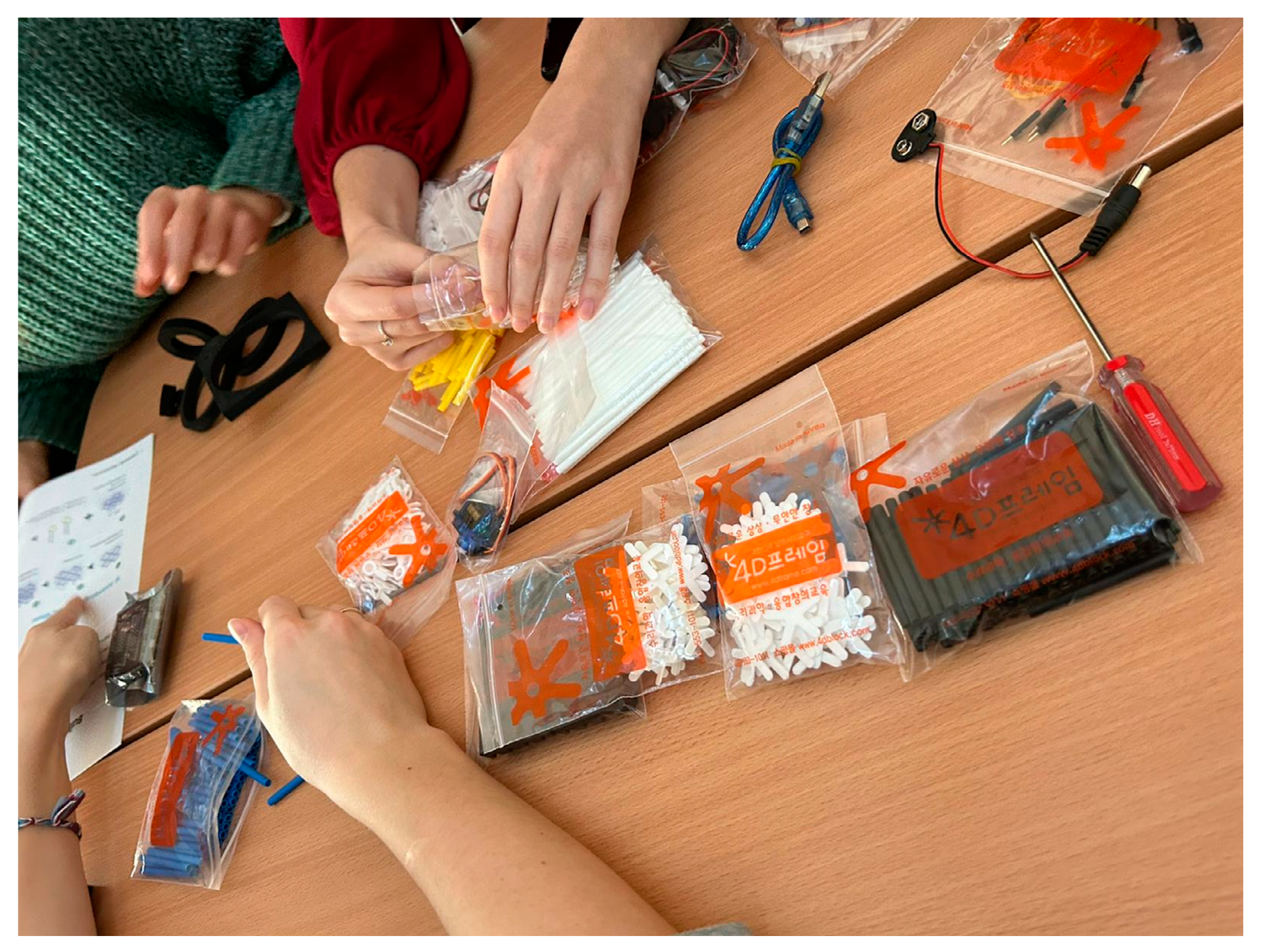

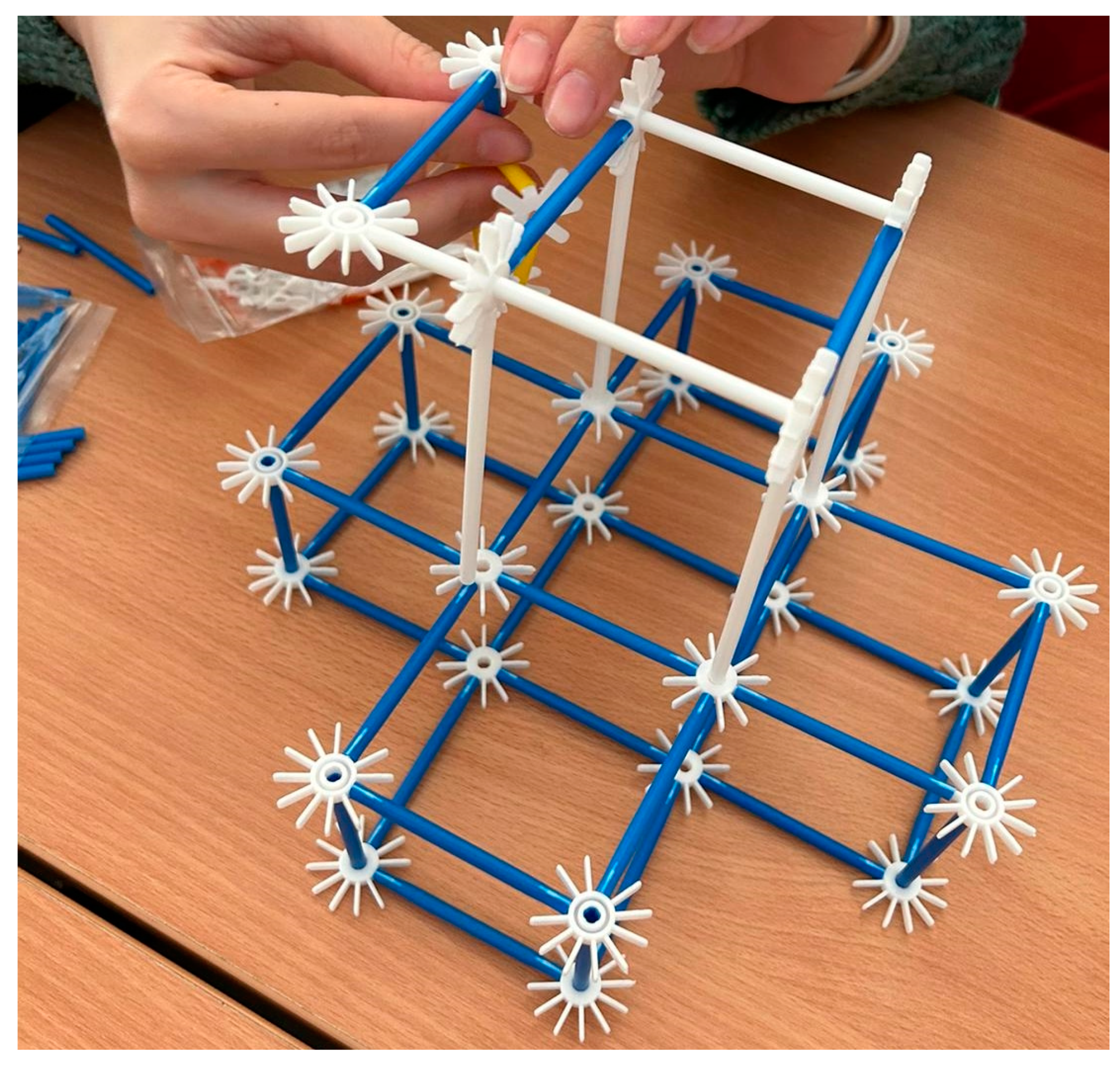
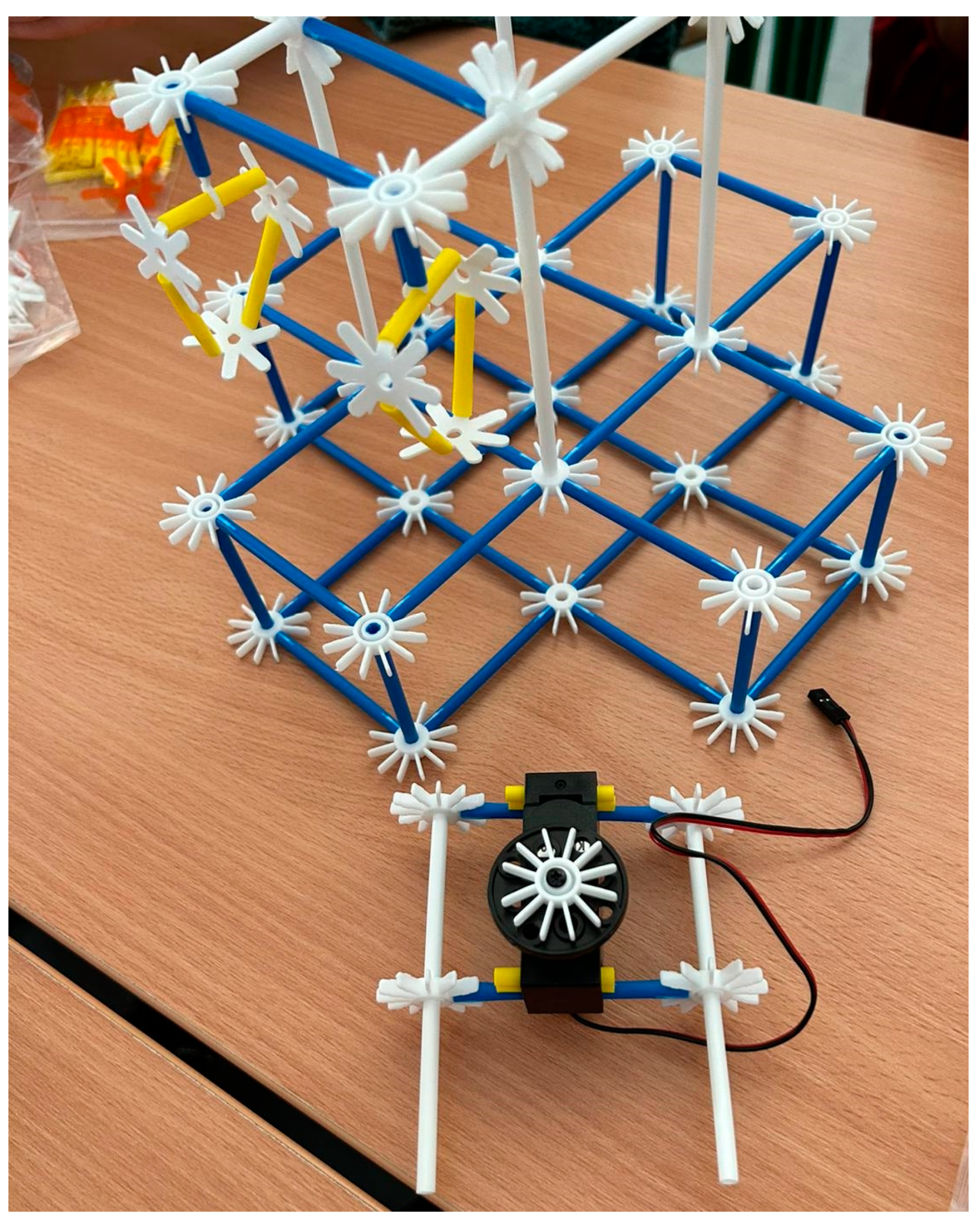
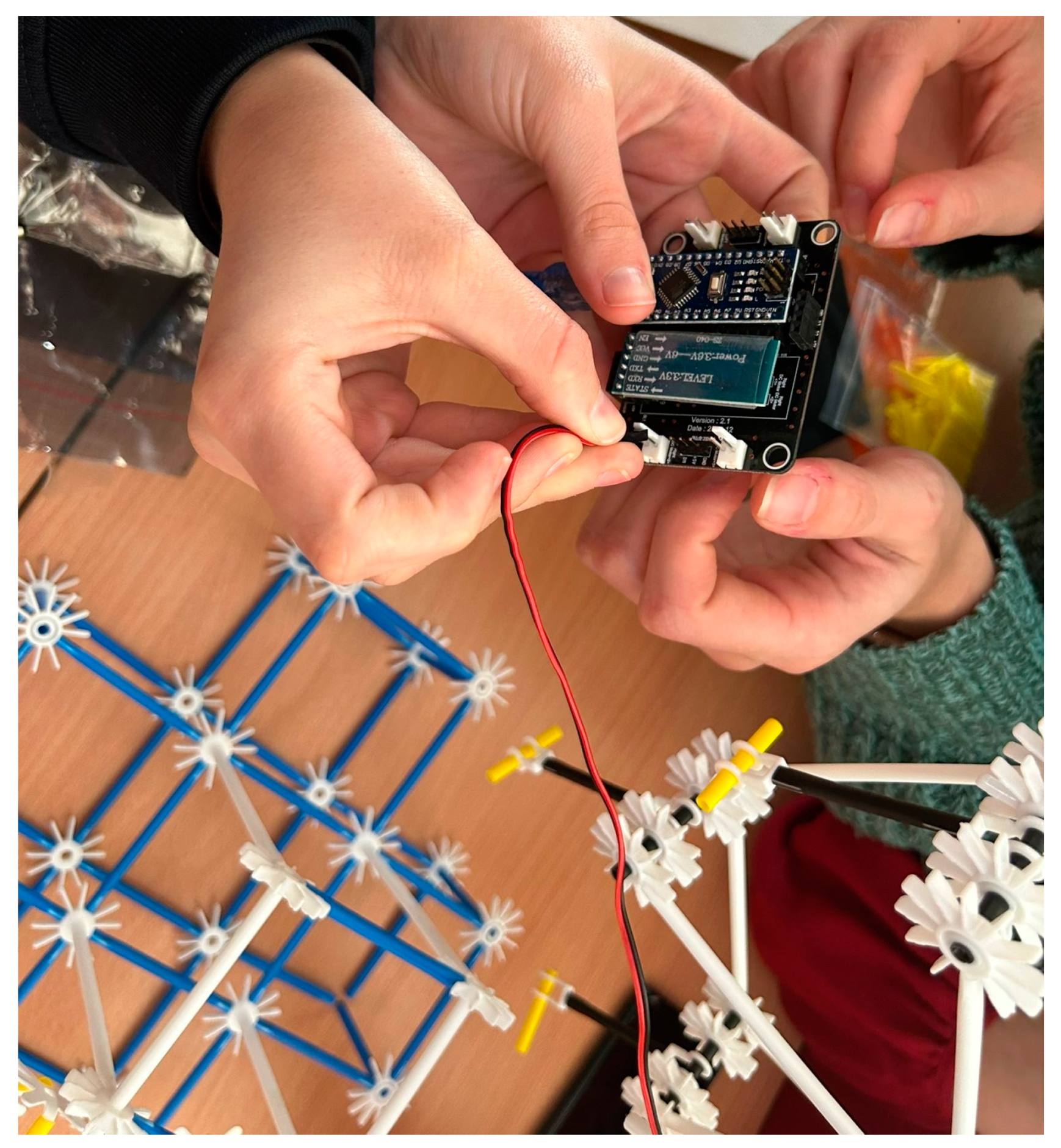


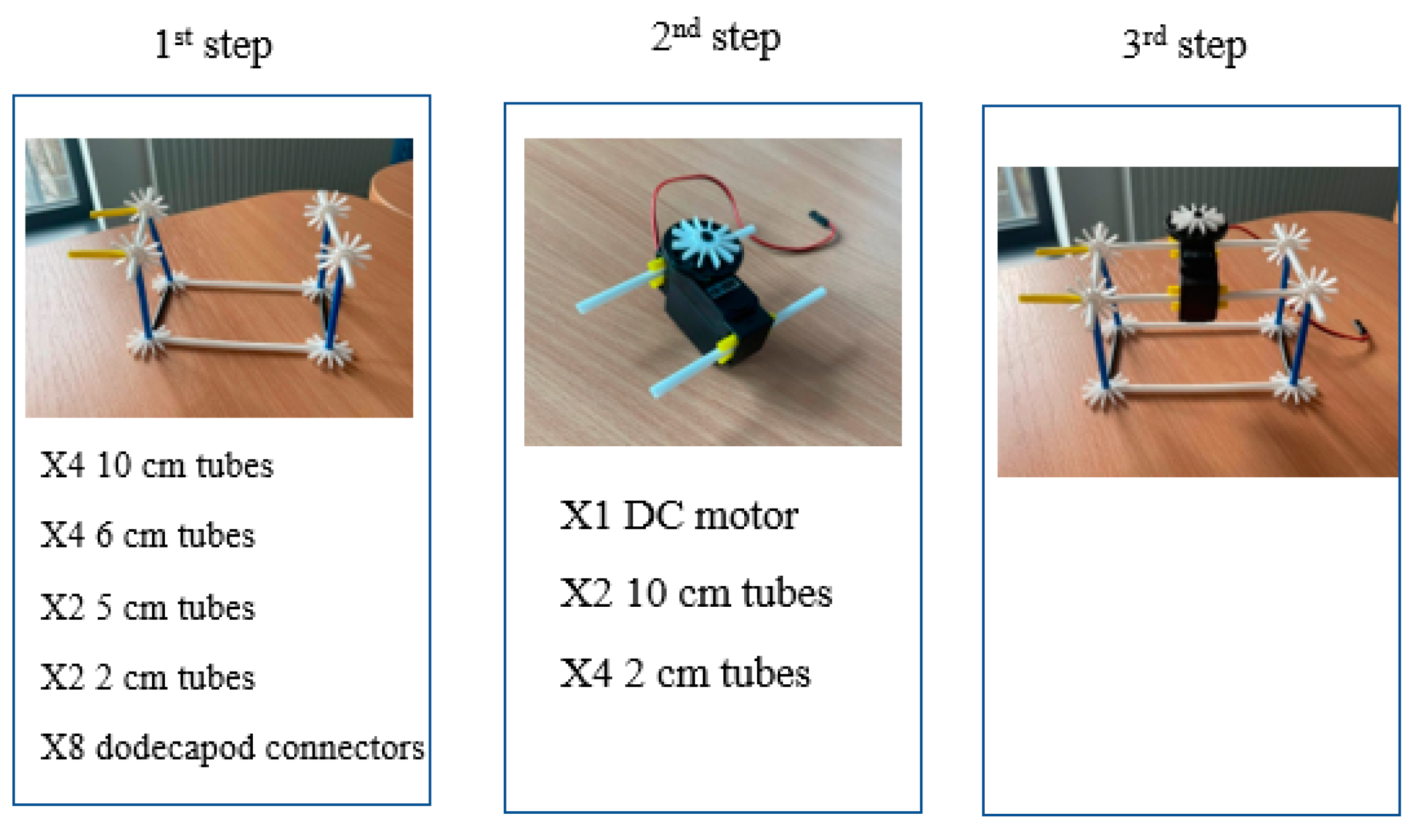


| Main Categories Related to Research Question No. 1 | Concepts | Saturation of Category |
|---|---|---|
| Student strategies Creativity and effective teamwork Equipment design skills Team problem solving skills Constructive discussions | Research of activities (material and its parts, instructions, inspirations on the Internet); Use of previous experience with a similar task (instructions first, then own solution to the problem, knowledge of material properties); Division of tasks and mutual cooperation based on communication: production of proposals, procedures, reflection and revision, appreciation and constructive criticism of ideas, proposals); Finding solutions (how to deal with problems—instructions, material). | 75 |
| Didactic interpretations—conditions that the teacher should ensure | Clear instructions; Hardy material; Group work; Sufficient time; Enable or relate to previous experience; Adequate challenge and related tasks (real product—usable in life, own creation of instructions—structure). | 75 |
| Potentials for optimizing learning conditions and processes via applying such activities | Entertainment; Active learning; Integration of subjects and learning areas; Development of psychomotorics; Manipulation of objects; Motivation (real product, collaboration, exploration, problem solving, appreciation, sense of accomplishment, authorship); Awareness of learning strategies and procedures (creating own instructions, reflection protocols). | 75 |
| Selected Research Significant Statements of Subjects or Their Sequences | Selected Questions of the Moderator in the Focused Interview Routing the Convergence of the Subject’s Point of View and Meaningful Contexts |
|---|---|
| “…We cannot fully imagine how students in the first grade of elementary school would manage to build such a structure…; …In the second lesson, we managed to complete activity 1. It was much easier than in the first lesson, as we already knew part of the procedure and we were also better played as a team…” “…The advantage was that the form of group work was chosen in this activity, while we helped and complemented each other…” “… each of us got involved, tried to contribute our ideas and help others in the group to make this carousel. | “…Could it be understood that you see a connection between the task in question and the teaching/learning conditions…?” “…What does that mean to you?…” |
Disclaimer/Publisher’s Note: The statements, opinions and data contained in all publications are solely those of the individual author(s) and contributor(s) and not of MDPI and/or the editor(s). MDPI and/or the editor(s) disclaim responsibility for any injury to people or property resulting from any ideas, methods, instructions or products referred to in the content. |
© 2024 by the authors. Licensee MDPI, Basel, Switzerland. This article is an open access article distributed under the terms and conditions of the Creative Commons Attribution (CC BY) license (https://creativecommons.org/licenses/by/4.0/).
Share and Cite
Guncaga, J.; Korenova, L.; Záhorec, J.; Ostradicky, P. Innovative Approach on Teaching and Learning with Technical Aids for STEM Education at the Primary Level. Educ. Sci. 2024, 14, 682. https://doi.org/10.3390/educsci14070682
Guncaga J, Korenova L, Záhorec J, Ostradicky P. Innovative Approach on Teaching and Learning with Technical Aids for STEM Education at the Primary Level. Education Sciences. 2024; 14(7):682. https://doi.org/10.3390/educsci14070682
Chicago/Turabian StyleGuncaga, Jan, Lilla Korenova, Ján Záhorec, and Peter Ostradicky. 2024. "Innovative Approach on Teaching and Learning with Technical Aids for STEM Education at the Primary Level" Education Sciences 14, no. 7: 682. https://doi.org/10.3390/educsci14070682







